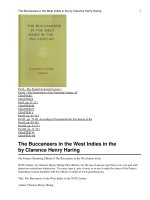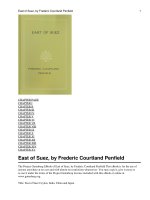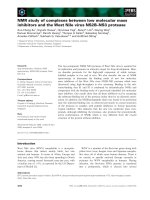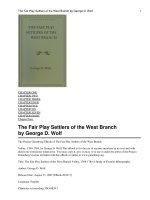The changing other footbinding, china and the west, 1300 1911
Bạn đang xem bản rút gọn của tài liệu. Xem và tải ngay bản đầy đủ của tài liệu tại đây (678.96 KB, 106 trang )
THE CHANGING OTHER:
FOOTBINDING, CHINA, AND THE WEST, 1300-1911
HE QI
NATIONAL UNIVERSITY OF SINGAPORE
2012
THE CHANGING OTHER:
FOOTBINDING, CHINA, AND THE WEST, 1300-1911
HE QI
B.A. (ZHEJIANG UNIVERSITY)
A THESIS SUBMITTED
FOR THE DEGREE OF MASTER OF ARTS
DEPARTMENT OF ENGLISH LANGUAGE &LITERATURE
NATIONAL UNIVERSITY OF SINGAPORE
2012
i
Acknowledgements
This thesis would not have been possible without the guidance, patience, and support
of the following people.
First and foremost, I owe deepest gratitude to my supervisor, Dr Ross G. Forman,
whose knowledge and wisdom greatly inspired me to write on this topic. Despite the
fact that he has other academic commitments, his encouragement, support, and
insightful advice from the preliminary to the concluding level enabled me to develop
a better understanding of the subject.
I would like to thank the two anonymous reviewers for their valuable comments and
criticisms, which enabled me to enrich this thesis. I also would like to express my
special thanks to my former teachers and friends, Professor Ernest Olson, Professor
Peter Swirski, and Ms Sichen Shou for patiently proofreading my scripts and giving
me invaluable feedback.
I am heartily thankful to all my friends who have been supporting me by all means
during the months of research and writing. My special thanks go to Gaoshao Cao,
Zhao Lu, Gao Shuang, Yanqing Li, and Jiaqi Hu, who have listened endlessly to my
ideas and complaints, and cheered me up when I was stressed out.
Finally, I am grateful to my mother and sister, who continue to show me the meaning
of unconditional love, and especially to my deceased father, who made me believe
that I am always trusted and blessed. It is to them that this dissertation is dedicated.
ii
Contents
Acknowledgements
i
Contents
ii
Abbreviations
iii
Summary
iv
Introduction:
1
Chapter 1: The Changing Other:
Shifting Western Interpretations of Footbinding
10
1.1. The Beautiful Other: Footbinding as Uniqueness
11
1.2. The Double-faced Other: Footbinding in the Nineteenth-century Encounter
15
1.3. The Ugly Other: Footbinding as Backwardness
20
Chapter 2: The Other to Be Changed:
Western Participation in Anti-footbinding Movement
33
2.1. Anti-footbinding under the Gospel of God
35
2.1.1. “Woman’s Work for Woman”: Christian Women and Mission Schools
39
2.1.2. “A Divine Force Needed”: John MacGowan and the Heavenly Foot Society 46
2.2. Secularizing Anti-footbinding: Mrs. Archibald Little and T’ien Tsu Hui
52
Chapter 3: The Changed Other:
Chinese Participation in Anti-footbinding Movement
60
3. 1. Anti-footbinding as Nationalism
62
3.1.1. Holding the Flag of Western Ideas
63
3.1.2. National Honour and National Strength
66
3. 2. Anti-footbinding as Feminism
3.2.1. A New Womanhood
73
76
Conclusion:
84
Bibliography
88
iii
Abbreviations
Primary sources of John MacGowan and Mrs Archibald Little are cited in this
dissertation using the following abbreviations:
Works by Mrs Archibald Little
IC
Intimate China: The Chinese as I Have Seen Them
LBG
The Land of the Blue Gown
RMPG
Round about My Peking Garden
Works by John MacGowan
HESC
How England Saved China
MMMC
Men and Manners of Modern China
iv
Summary
During centuries of interaction between China and the West (Europe and America),
footbinding, for its uniqueness and otherness, had always served as the perpetual
symbol of China in Western imagination and narration of the land and its people. This
thesis describes the shifting circumstances through which Westerners attempted at
first to justify and then to eradicate the practice of footbinding. With a focus on the
nineteenth century, this thesis covers a historical span of five centuries, from the
fourteenth century, when the first Westerner, the Franciscan friar Odoric of Pordenone,
wrote about footbinding, to 1911 when the practice was officially outlawed by the
Republic of China. It argues that Western interpretations of footbinding roughly
corresponded to Western images of China. During the period when China was the
more powerful party in interactions with Western nations, Western descriptions of
footbinding tended to be positive, as one of many admirable elements of Chinese
civilisation. During the nineteenth century, when the power relations were reversed,
dominant Western interpretations of footbinding were negative, as one of many
barbaric customs that marked China as a backward nation. Therefore, missionaries
and other groups of Westerners initiated campaigns to eradicate footbinding. Seeing
their nation through Western eyes, Chinese elites joined anti-footbinding movements
in the hopes both of modernising the nation and of saving China’s international face.
The sources used in this thesis consist of Western travel accounts and missionary
reports, and Chinese journals and newspapers published from the seventeenth to early
twentieth centuries. The first chapter examines representative Western travel writings
of footbinding from the 1300s to the 1900s, during which the meaning of footbinding
changed dramatically, from the positive one in earlier centuries to a vastly negative
one in the nineteenth century. Essentially, what these travellers made of footbinding is
v
consistent with the shifting relationships between China and the West. The second
chapter focuses on Western discourses of footbinding produced by nineteenth-century
missionaries and feminists who resided in China. In light of the idea that posited that
nonconformity with Western ways and values meant backwardness, China’s
difference – embodied in the bound foot – was used to justify a sense of superiority
and subjectivity in saving Chinese women. Missionaries initiated anti-footbinding
campaigns, which reached their peak when Mrs Archibald Little, a non-missionary
and feminist, established the Natural Feet Society in 1895. Although Westerners were
not necessarily the decisive force in the eradication of footbinding, they exerted an
indispensable influence on the Chinese, especially the elites; and, more importantly,
they popularised a cause whose time had come. China’s defeat in the Sino-Japanese
War of 1894-95 heavily struck the Chinese, and roused their awareness of a national
crisis. The enlightened Chinese woke up to the call of Western anti-footbinders. They
appropriated footbinding as the scapegoat for China’s weakness, and brought the antifootbinding movement to the service of nationalism, with the ultimate purpose of
preventing China from being colonised by the West. Therefore, the Chinese antifootbinding discourse I review in the last chapter presents the responses of the
Chinese “Other” to the gaze of the West.
1
Introduction
A woman with a pair of bound feet has been a horrible image for the West, 1 but
bound feet were once admired in China as a “golden lotus,” a marker of beauty and
gentility. The practice of footbinding that created such an image of horror and beauty
has lasted for over a thousand years in China. Throughout the centuries, enlightened
and liberal thinkers often criticised footbinding, and actions were taken by Chinese
rulers in various dynasties to abolish this practice, which turned out to be in vain. It
was between the late nineteenth century – when Western missionaries took the
initiative in the anti-footbinding movement – and the early twentieth century – when
some radical Chinese reformers and revolutionaries integrated the abolition
movement with other emancipation reforms for the Chinese woman – that footbinding
was outlawed and gradually eradicated. Even though its origins remain a myth,
footbinding, be it in China or in the West, has always been an object of praise and
criticism, of admiration and condemnation, of elegance and barbarism.
My thesis focuses on Western representations of footbinding in travel accounts,
journals, official reports and other sources from 1300-1911, with an emphasis on the
period between 1840 and 1911, when relations between China and the West
underwent a sea change. With a study of the rise and fall of footbinding, I will argue
that how writers interpreted footbinding is actually a product of a series of historical
and social changes within the West and in China, and of the power relations between
these two regions. In spite of the numerous writings about footbinding, the custom
itself, or the distorted women’s bodies, was neither the prime concern of, nor
culturally significant to, the Westerners nor the Chinese. Instead, the circumcised feet
1
In this thesis, “the West” refers to Europe and America, and “Western” means Euro-American.
2
served as the quintessential symbol of otherness through which the West could
express its praise and criticism of the Chinese Other, be it an admirable one, or a
contemptible one, which had served as a contrastive image of the West itself. Chinese
interpretations of footbinding as a barbaric and shameful practice, particularly from
the late nineteenth century, were an echo of the Western gaze at the Chinese Other.
They also reflected the self-adjustment China made during its interactions with the
West, especially in the late nineteenth and early twentieth centuries. My aim here is
to open up and extend the perspective of analysing the interpretations of footbinding,
both in China and in the West, by considering its relationship with other social and
cultural changes such as the orientalism, imperialism, colonialism, feminism, and
nationalism of the period.
In both China and the West, quests for footbinding’s origins have never stopped.
However, its origin remains a myth. 2 Footbinding has caused much comment in
Western writings about China since the first mention of it by the friar Odoric of
Pordenone (d. 1331) in the 1300s. In centuries following Odoric’s arrival, particularly
from the second half of the nineteenth century, more and more Westerners stepped
foot on Chinese land. Among these were merchants, diplomats, and missionaries.
During centuries of interactions with the Chinese people, these Westerners had also
witnessed or participated in the historical and social changes in the country, and
produced a large number of comprehensive literary materials about this country,
including its history, politics, geography, arts, sciences, literature, religion, laws,
2
Generally, scholars agree that there is no historical evidence of the existence of footbinding prior to
the Tang dynasty (618 - 906). See Fu Yuechen, “(The Life of Tang Women),” Zhongguo funushi lunji
(Readings in the Chinese Women’s History), 1sted, ed. Pan Chia-lin (Taipei: Cowboy, 1979) 165-180.
According to Chinese traditional accounts, the practice dated back to around the mid-tenth century. See
Chen Dongyuan, Zhongguo funu shenghuo shi (History of the Lives of Chinese Women)(Shanghai:
Shangwu yinshuguan, 1937) 124; Jia Shen, “(An Investigation into Chinese Women’s Footbinding),”
Zhongguo funushi lunji (Readings in the Chinese Women’s History), 1sted, ed. Pan Chia-lin (Taipei:
Cowboy, 1979) 183-185. Howard S. Levy even gives the approximate date of the first reference to
footbinding --1130 A. D. See Levy’s Chinese Footbinding: The History of A Curious Erotic Custom
(New York: Rawls, 1966)17.
3
customs, and the social and moral condition of the people. The accounts and
comments on footbinding in these writings are the materials of my thesis. The
literature that they produced is substantial, but I will focus on those sources which are
more readily available – works that have appeared in print and mainly in English.
Some of the materials are the first-hand experiences of writers who held high
positions in organisations or who could claim expertise on the footbinding such as
diplomats or missionaries; some are travellers who took account of everything they
saw or experienced, or even took on the tinge of their own imagination or affections.
In many cases, the print sources that are being drawn upon are the personal narratives
of missionaries, but there are sources published in other forms and for other purposes.
The various contexts in which the narratives were published, either as an article in a
mission periodical, a book of memoir by a mission press, or a travelogue for popular
consumption, alter the kind of foreign observers’ impression of footbinding.
As a heated topic within China and outside, various minds have applied themselves
to the interpretation of footbinding. Perhaps the most powerful and influential is
Freud’s psychological-sexual explanation which regarded footbinding as fetishism
(1963). This idea has been supported by Julia Kristeva in About Chinese Women
(1991: 81-85) and Howard Levy in Chinese Footbinding: The History of A Curious
Erotic Custom (1966). Similarly, Jackson Beverley (1997) dubbed footbinding an
“erotic tradition,” which was contested by Hill Gates (2008) who found little evidence
for its sexiness (58-70). In addition to the psychological interpretation of footbinding,
another popular explanation is the attachment to gentility. The sociologist Thorstein
Veblen’s Theory of the Leisure Class (1925) attributed the idea of footbinding to socalled “conspicuous consumption,” which demanded that the figure of women of the
leisure class be hazardously delicate and slender, with “diminutive hands and feet and
4
a slender waist” (148). He argued that one of the rationales behind footbinding was to
demonstrate the “pecuniary reputability” and “pecuniary strength” of the male owner
by showing that he could afford the idleness of his woman, who was “useless,
expensive, and must be supported in idleness”(148-149). Veblen’s theory sounds
reasonable only in relation to the early history of footbinding, when it was a privilege
of the leisure class. However, when the practice was widely adopted by peasant
women in the Qing dynasty, it became a cult that was no longer a privilege of the
upper class and no longer served solely as a mark of gentility.
One theory for the flourishing of footbinding among commoners was the
“marrying-up” thesis (Ko 2005, 3; Greenhalgh 1977, 9). Many girls believed that it
was not a beautiful face but a pair of bound feet that was the essential criterion to
catch their prospective husbands.
3
Thus, bound feet were translated into a
marriageable sign and became the ticket for many girls and families to the brighter
future. However, surveys by Bossen, Wang, Brown, and Gates (2011)4 have contested
the “marrying-up” theory,” as they proposed that footbinding in rural area was not just
a symbol of beauty, but also an integral part of economic system, dependent on
women’s intensive domestic handwork such as spinning yarn, processing tea and
chucking oysters, which required females to sit for hours (439). The illuminating
theories of Freud, Levy, Veblen, Bossen and Wang explain some, but not all, of the
reasons behind the spread and endurance of this practice. Fetishism is an
interpretation of some Chinese men’s sexual fantasies of small-footed women
3
As a lady in Shangdong recalled, “Match-makers were not asked ‘Is she beautiful?’ but ‘How small
are her feet?’ A plain face is given by heaven but poorly bound feet are a sign of laziness.” See Ida
Pruitt, A Daughter of Han: The Autobiography of a Chinese Working Woman (Stanford, Calif.: Stanford
UP, 1967) 22.
4
They did surveys of rural bound-foot women in two counties in Shaanxi province. They found that
only a small proportion of bound-foot women married someone of a higher class. About fifty percent
married the same class and some ended up in a lower one. For details, see Bossen, Laurel, et al. “Feet
and Fabrication: Footbinding and Early Twentieth-Century Rural Women's Labor in Shaanxi.” Modern
China 37.4 (2011): 347-383.
5
depicted in erotic paintings or literary works. Hill, Gates, Laurel and Bossen’s
“mystification of female labor” theory has explanatory power mainly for the modern
period, when footbinding was widely carried out by peasant women.
As Dorothy Ko (1997) has pointed out, footbinding is an ongoing and enduring
process that cannot be assumed as a uniform and timeless practice motivated by a
single cause. It is “not one monolithic, unchanging experience that all unfortunate
women in each succeeding dynasty went through”, but is “an amorphous practice that
meant different things to different people”; in other words, a “situated practice” (15).
In another essay, Ko (2002) explores the dialectics of body and text in the malecentred Confucian discourse before the nineteenth century, and analyses the aesthetics
of fashion and ornamentation. The basic tenet of her essay is that “any effort in
making sense of footbinding has to begin with an appreciation of the enormous power
of writing and the written world in the production and maintenance of Confucian
traditions” (177). Contradictory to the prevalent view that regarded footbinding as a
barbaric practice, Ko explains it as a form of the female expression of wen (civility
and gentility) in the Confucian cultural world (149-150). Ko (1994) argues that
footbinding reinforced the spatial organisation that embodied the separate domains of
the inner/outer and male/female, and restructured the woman’s body itself (147). The
female-exclusive rituals of footbinding, including the materials needed and the
specifically selected date of binding with a prayer to the gods, served as an effective
tool of socialisation. It also helped define the mother-daughter relationship, as well as
the girl’s interaction with other women (149-150). In other words, the practice was
internalised within the private space barred to men, and was thus an essential feature
of femininity. These help valorise women’s cooperation in the practice of footbinding,
and therefore help explain the perpetuation and spread of the custom.
6
Most authors on footbinding referred to Chinese sources to interpret the practice
and mainly concentrated on the earlier periods before the twentieth century, since the
meaning of footbinding shifted from the mid-nineteenth century. This is despite the
fact that the credibility of Western sources is questioned, for example by Ko (1997)
who argues that the Westerners’ accounts of footbinding “cannot be accepted at face
value” because they were written “either in a scientific tone of objective observation
or as an impassioned plea for abolition” (9). I agree that some Western observers,
especially travellers, may not be professionally trained or may be unreliable witness.
Some of them took down what they heard without judging its accuracy; some
generalised what they saw in a certain parts of China to cover the whole country; and
some expressed a sense of superiority, interpreting the practice without probing into
the cultural meanings behind it. From this point of view, Western sources are not
objective, but most writers have a certain bias, especially those who went to China
with an explicit purpose like merchants, diplomats, and missionaries. However,
Western sources still contain more valuable information about other aspects related to
footbinding than about the practice itself, such as inconsistent Western attitudes, a
changing Western society, and the shifting power relations between China and the
West. Their subjective and even prejudiced opinions of footbinding are determined by
and also a reflection of the times, which were also in a changing state. Therefore,
judging whether the accounts or opinions are accurate or seeking truth is not as
challenging or meaningful as analysing factors that have attributed to those opinions.
It is, therefore, valuable to analyse Western interpretations of footbinding, not only to
decode cultural meanings embodied in this traditional custom, but also to enrich our
understanding of the changing China and the West, and the shifting relationships
between these two regions within the period examined. They are consequently an
7
important area of study.
The title of this thesis is intended to foreground the importance of the changing
historical and social context in assessing the interpretations of footbinding in China
and the West over centuries. “Changing” is the key word, both in terms of footbinding
as a cultural practice itself and the centuries’ interactions between these two regions.
The early history of Western interpretations of footbinding before the nineteenth
century reveals a long-standing Western desire and fantasy for the Chinese Other. The
relentless quest for the origins of this custom, and the generally positive attitude
toward it, were projections of such a desire and fantasy of Chinese culture during this
period. With the opening of China from the 1840s, the myth that had covered
footbinding as well as China was gradually removed. What was exposed was a
practice and a country that was vastly different from what was previously imagined or
seen by the West. Responses in both China and the West to such a change forged a
shifted image of footbinding, which in return projected the observer ’s own historical
moment and context.
This thesis is divided into three sections. In the first chapter,5 I examine selected
Western interpretations of footbinding from the 1300s-1900s. These interpretations
were produced by Westerners who went, or imagined their journeys to China in the
same period. I will argue that footbinding was taken by most of these writers as an
allegory of China, or rather, the otherness of China, and its meaning changed with the
altering Western image of China, both of which were products of the shifting
relationships between China and the West.
While the first chapter covers the whole period from the first mention of
footbinding in the West in the 1300s to its heyday, and until 1911 when it was
5
Part of this chapter was presented as a paper entitled “Changing Self and Other: Shifting Western
Interpretations of Footbinding, 1300-1900,” in the Twelfth Humanities Graduate Research Conference,
Curtin University, Australia, 19-20 October 2011.
8
officially outlawed in China, the second chapter focuses only on the final part of the
period from the 1840s when the meaning of footbinding was rapidly shifting to the
negative. In the light of a nineteenth-century prevailing Western idea positing that
change meant progress, China’s restrictive trade policies and stagnant social norms
appeared artificially confining and retrograde. Western responses to China were
reflected in their denunciation of footbinding. Many attacked footbinding for its
mutilation of women’s bodies, and as a backward and barbaric practice, but their
attitude was formed within the context of Western superiority and of a prejudiced
denunciation of other aspects of Chinese civilisation. The missionaries whose writings
I take up in this chapter commented fervently on footbinding, which set the prevailing
tone for the interpretation of footbinding since the 1840s. Their predominant outlook
in this period displayed a thoroughgoing defiance of this practice. Missionaries took
the initiative in the anti-footbinding movement in China by establishing antifootbinding societies and mission schools. In condemnations of footbinding, they
conveyed to the Chinese the Christian ideology of body, and the new notions of ideal
womanhood. 6 As a complementary force for Western participation in eradicating
footbinding, Mrs Archibald Little, a non-missionary, played an indispensable role.
The values she advocated in her anti-footbinding society epitomised what was upheld
about the New Woman, a feminist ideal emerging in England in the late nineteenth
century.
Together, a mixture of missionaries and non-missionaries built a nationwide
movement for change to eradicate the hard-dying practice of footbinding. While it
6
Missionaries were not unanimously active against footbinding. Some societies, particularly the
London Missionary Society, was more inclined to describe and act against this practice. However,
owing to the limitation of my knowledge of the history of missionary societies in China, I do not, in
this thesis, clearly differentiate different sects of missionaries, or explain the historical reasons why a
certain group was more active than others in crusading against footbinding during the late nineteenth
century. This is an issue that I intend to explore in my further study of this topic.
9
was Westerners who initiated the anti-footbinding movement, and they were
instrumental in the early period of the movement in terms of popularising antifootbinding ideas, from 1890s onwards, however, the leadership passed to the local
“modernised” Chinese. Therefore, the last chapter concentrates on the Chinese
appropriation of the Western discourse on footbinding as a response to the West’s gaze
at the Chinese Other. This chapter specifically deals with Chinese actions in the antifootbinding movement from the 1890s to 1911, from perspectives of nationalism and
feminism. Based on the analysis of the perspectives of both male and female Chinese,
I will argue that although they protested against footbinding from different
standpoints, they fell into the Western way of thinking of it as an allegory of the
nation itself, and took advantage of the anti-footbinding agitation to realise their
purposes of national reform or revolution. Finally, with the joint forces of
campaigning outsiders and modernising insiders, footbinding as the otherness of
China, as well as the Chinese Other itself, changed.
10
CHAPTER ONE
The Changing Other: Shifting Western Interpretations of Footbinding
Ever since the first century A.D., when contacts between China and the West began
through the Eurasian land routes known as the Silk Road, the two opposite sides of
the same landmass envisioned each other as strange places with strange people and
cultures. From the sixteenth century, after the discovery of sea routes to ports in Asia,
Western traders and missionaries began over two hundred years of interaction with
China. During centuries of contact between these two regions, China in the West’s
narration was intentionally described as peculiar and odd; in effect, the Other. Many
Western authors deliberately stressed those qualities that made China different, and
relegated it to an irretrievable state of otherness. Between the sixteenth and nineteenth
centuries, thousands of Westerners ventured to China. These travellers, who were
often officials, missionaries, or merchants, usually began their journeys with support
from a nation or an empire of military or economic strength, or with intellectual and
spiritual faith. Most of them felt compelled and obliged to note down observations for
their particular audience: generally their fellow-countrymen, colleagues, patrons or
monarch. 7 Aware of their audience, they consciously selected certain pieces of
information in which this audience might be interested, or stressed aspects of a
country or characteristics of its people that would resonate with the perceptions of
their own cultures. Thus, from the very start, footbinding, as a unique characteristic of
China and its people, came to be viewed by many Western travellers as a symbol and
validation of Western beliefs regarding Chinese myth. Therefore, from the Franciscan
friar Odoric of Pordenone – the very first Westerner to write about footbinding in the
7
For a discussion on European travel writers’ awareness of the readership, see Rana Kabbani, Europe’s
Myths of Orient (London: Macmillan, 1896) 1.
11
fourteenth century – to missionaries, diplomats, and merchants in the early twentieth
century, Western travellers to China never failed to notice and comment on the small
feet of Chinese women. So what captured these Westerners’ enduring interest in the
feet of exotic women? What symbolic meanings did the small feet entail throughout
the centuries’ interactions between China and the West?
The focus of this chapter is on the discourse of footbinding produced by Western
travellers during interactions with their Chinese counterpart between the fourteenth
and nineteenth centuries. I will argue that the Western interpretation changes
according to the period in which the author writes, and is influenced by the culture
and knowledge in which s/he grows and is schooled. As such, the shifting
interpretations reveal the changing historical and cultural backgrounds in general,
particular the shifting power relationships between China and the West.
1.1. The Beautiful Other: Footbinding as Uniqueness
Although the present public image of footbinding is negative, owing to the great
damage it did to women’s bodies, footbinding has not always been seen as backward
or inferior in Western narrations. From the start, when the first Westerners who
journeyed to China mentioned footbinding, it glittered in positive light. Early Western
travellers deemed it a sign of China’s uniqueness and a symbol of the Chinese taste of
beauty. The friar Odoric of Pordenone,8 who arrived in China in 1322, was the first
Westerner to refer to footbinding as a parallel to the male custom of growing long
fingernails, both of which were markers of gentility. 9 Although the authenticity of
Odoric’s various descriptions and accounts of China has frequently been questioned,
8
On Odoric, see Arthur Christopher Moule, Christians in China before the Year 1550 (London: Society
for Promoting Christian Knowledge, 1930) 241-48; Nigel Cameron, Barbarians and Mandarins:
Thirteen Centuries of Western Travelers in China, Phoenix ed (Chicago: U of Chicago P, 1976) 107-20.
9
Donald F. Lach, Asia in the Making of Europe, 3 vols. The Century of Discovery, vol.1. The Century
of Discovery, 4 books (Chicago: U of Chicago P, 1965) 1: 41.
12
since he usually accepted at face value stories told by others, modern scholars accept
them as essentially reliable (Yule 2: 23-25). Ever since then, footbinding became a
topic so popular that few Western writers on China failed to mention it, and travellers
to China expected to see it.
The sixteenth century was an age of relatively benign and limited relations
between China and the West, when tales of the admirable Cathay told by Marco Polo
were still vivid in Westerners’ minds. Most Western travellers who wrote about China
during this period tended to regard footbinding as an admirable sign of China’s
civility to secure female chastity. Juan Gonzalez de Mendoza (c. 1540-1617), the
author of the first Western history of China, in his book Historia de las cosas mas
notables de la China (1588) offered a comprehensive descriptive and geographical
survey of China’s history and culture. The largely positive coverage of China in the
book set the tone for Western descriptions of China in the next century. He used the
word “ingenious” in describing the practice of footbinding:
Amongst them they account it for gentilitie and a gallant thing to have little
feet, and therefore from their youth they do swadell and binde them verie
straight, and do suffer it with patience: for that she who hath the least feete is
accounted the gallantest dame…the lameness of their feete is a great helpe
ther-unto. The women as well as the men be ingenious. (21)
Here, Mendoza commented on the symbolic meaning of little feet as a mark of
gentility and gallantry, which he believed was the connoted reason for women’s
willingness to suffer the pain with patience from childhood. By calling footbinding
“ingenious,” Mendoza’s tone was ethnographic and impartial, which neither explicitly
nor implicitly approved the practice. However, he did set a relatively gentle and
positive tone of interpreting footbinding for his successors. At roughly the same time,
13
the Portuguese Dominican friar Gaspar da Cruz (c. 1520-1570) expressed a similar
idea when commenting on Chinese women’s appearance:
The women commonly, excepting those of the sea coast and of the mountains,
are very white and gentlewomen, some having their noses and eyes well
proportioned. From their childhood they squeeze their feet in cloths, so that
they may remain small, and they do it because the Chinese do hold them for
finer gentlewomen that have small noses and feet. This withal is the custom
among the well-bred people, and not among the basest.10
Here, in Chinese women (the Other, “them”), described as “white” as a marker of
superiority, and “gentlewomen,” this friar actually saw images of the ideal women in
his own country (Self, us): fine-skinned and gentle. Surely, daintiness and whiteness
were also prized by the Chinese themselves, which was evident in portraits of upperclass Chinese women, with a special emphasis on the whiteness of the face. In this
sense, like small noses and white skin, a pair of small feet was a distinction between
the “well-bred” and the “basest.”
Footbinding, according to Mendoza, was not only a marker of gentility, but was
also designed by men to keep women at home and, hence, to safeguard feminine
chastity. He stated that “the men hath induced them unto this custom,” and because of
“the lameness of their feet,” women could not “go but little abroad.” Thus,
footbinding was “invented only for the same intent” (32). The later travellers of the
seventeenth century – for example, the Jesuit missionary Matteo Ricci (d. 1610), the
French historian Michael Baudier (c. 1589-1645), and the Spanish friar Domingo
Fernandez Navarrete (c.1610-1689) – all contributed to Mendoza’s interpretation of
footbinding as a Chinese invention to keep women virtuously at home. They thought
10
Charles Ralph Boxer, ed. South China in the Sixteenth Century: Being the Narratives of Galeote
Pereira, Fr. Gaspar da Cruz, O. P. and Fr. Matin de Rada O. F. S. A. (1550-1575) (London: The
Hakluyt Society, 1953) 149.
14
this invention was a strong point of China and was advisable for other countries to
adopt.11 In the eighteenth century, this instrumentalist view of footbinding was even
developed into a design with political purposes. 12
There were two major factors accounting for the positive image of footbinding in
the West before the nineteenth century. First, although footbinding was widespread in
the Ming dynasty (1368-1644), it was still exclusively practiced by upper- class
women. Thus, small feet were indeed a mark of gentility, as only the rich could afford
the idleness of women. Besides, naked feet were considered by the Chinese at that
time to be relatively private, and it was offensive and almost impossible for men
(except the woman’s husband or family) to look at them. Therefore, this invisibility
eroticised the bound feet and intensified their mystery, which was consistent with the
Western image of China that was as mysterious and as erotic. Second, the positive
Western attitude toward footbinding was also in keeping with the benign relationship
between China and the West during each of these centuries. The period before the first
half of the eighteenth century could be condensed into “sinomania” in the West,
which was at its height from the late seventeenth to the mid-eighteenth century. 13 The
general tone of writings on China during this period – for example, Marco Polo,
Matteo Ricci, and others – was rosy, positive, and admiring, seeing China as “Cathay,”
or the “Central Kingdom,” representing a serious, if not necessarily superior,
alternative to the West. Therefore, different as it might be, footbinding, like China
itself, was viewed as the Other that was positive, admirable, and beautiful.
11
See Michael Baudier, The History of the Court and the King of China: Out of French (London:
Christopher Hussey, 1682) 21-22.
12
For example, both Du Halde and Abbe Grosier believed footbinding was a “political design” or
“political expedient” to keep women in the permanent state of dependence by confining them within
the most inward part of the house, preventing women from participating in political activities or asking
about political issues. See J. B. Du Halde, The General History of China, 4 vols. (London: J. Watts,
1736) 2: 139; Jean Baptiste Grosier, A General Description of China, 2 vols.(London: Printed for G. G.
J. And J. Robinson, 1788) 2: 300.
13
John S. Gregory, The West and China since 1500 (New York: Palgrave Macmillan, 2003) 47.
15
1.2. The Double-faced Other: Footbinding in the Nineteenth-century Encounter
Ania Loomba (1998) has reminded us that the images of the Orient as a timeless
opposition of the West, or as the Other, had circulated for a long time before
colonialism. Images of the Other were “moulded” and “remoulded” through various
contacts between Western and non-Western peoples (58). Late nineteenth-century
travellers to China were still heirs of earlier traditions of representations of the
country and its people. They expected to encounter, and seldom failed to mention, the
differences they observed. John Scarth (1860), a Briton who spent twelve years in
China, recalled that on his first arrival in China in the 1840s, he was struck and
amused by the “contrariety of the native modes of doing anything,” and soon he made
out a long list of the “opposites” of the Chinese manner and character to those of the
British. Right after this comment, he concluded that “the Chinese character is the
exact opposite to that of Europeans generally” (95). More than a half-century later,
when the American traveller William Jennings Bryan (1907) arrived in China in the
early twentieth century, he still cherished the image of China as the Other and could
not help delineating the great difference between the “Flowery Kingdom” and the
United States. As he put it, even though China and America shared the same stars
overhead and abided by the same laws of nature, “in modes of living appearance,
customs and habits of thought the Chinese people could scarcely be more different
from ours” (101). To a certain extent, travellers who journeyed to China in the
nineteenth century continued to contribute to the image of China as the Other,
whether the image was the same as or different from their ancestors’. On the one hand,
they arrived in China expecting to see and therefore instinctively attracted to issues
that had been mentioned and had captured audiences’ interest in their home countries,
such as little feet and long nails. Naturally, there was a continuum in terms of topics
16
raised by newcomers. On the other hand, these new arrivals were more likely to seek
differences in the same issue, trying to add values and credibility to their own
travelling by pointing out errors in their ancestors’ writings. In other words, these
encounters necessitated both the continuity and affirmation of the previous images of
some cultural practices, when the images were just what they expected, and a
reconstruction of them, if different to the previous ones.
Footbinding, as a perfect symbol of China’s difference to the West and a longlasting topic in Western writings about the Chinese Other, appeared as catchy to
Western travellers in the nineteenth century as it did to those in previous centuries,
and they never failed to note it down in their observations of this practice in the new
era. Taking with them some previous interpretations of footbinding in the print of
their ancestors, there was, to a certain extent, some consistency in what they made of
footbinding in this later period.
John Francis Davis (1795-1890), a British diplomat who was chosen to accompany
Lord Amherst on his embassy to Peking in 1816, and who was governor of Hong
Kong from 1844 to 1848, inherited his predecessors’ views of footbinding. Davis
(1840) commented on the custom as “the most unaccountable species of taste … for
which the Chinese are so remarkable.” He deemed:
As it would seem next to impossible to refer to any notions of physical beauty,
however arbitrary, such shocking mutilation as that produced by the cramping
of the foot in early childhood, [footbinding] may partly be ascribed to the
principle which dictates the fashion of long nails. The idea conveyed by these
is exemption from labour, and as the small feet make cripples of the women, it
is fair to conclude that the idea of gentility which they convey arises from a
similar association. That appearance of helplessness which is induced by the
17
mutilation they admire extremely … and the tottering gait of the poor
women … they compare to the waving of a willow agitated by the breeze …
[With] this odious custom … the women are fully revenged in the diminution
of their charms and domestic usefulness.(1: 255-256)
Here, in attempting to explain footbinding, Davis paralleled it with long nails, a
feature that was familiar to Western readers as a symbol of gentility, since it was
ubiquitous in previous descriptions of Chinese characteristics. He attributed
footbinding to the idea of “exemption from labour” or “gentility,” but his comments –
such as “it would seem” and “may partly be” – indicate that Davis was uncertain
about the exact reason why footbinding was practiced. As with many other travellers,
he followed his predecessors’ description of the custom. Be that as it may, compared
with the word choice of his ancestors in commenting on footbinding – for example,
Mendoza’s “ingenious” – Davis used the words “mutilation,” “odious,” and
“diminution of charms.” Not only did these words reflect Davis’s disgust toward
footbinding and sympathy to “the poor women,” but they also indicated at least a
changed tone in describing this custom.
Similarly, Justus Doolittle (1824-1880), who sailed to China in 1849, believed that
footbinding was “fashionable”, and small feet, considered by the Chinese as
“beautiful” and “good-looking”, were an “index of gentility” (2:201). William C.
Milne (1785-1822), the second Protestant missionary to China, introduced
footbinding when describing his life in China. Although he described the bound feet
as “the cramped foot,” like Davis, who called the practice “artificial deformity”
(Davis 1: 255), he acknowledged that “the bandaged feet of Chinese ladies”,
complimented as “golden lilies”, was “an essential among the elements of feminine
beauty” (Milne 12). Like Milne, Thomas Thornville Cooper (1839-1878), who
18
journeyed along the Yangtze River into the Western part of China, in his travelogue
published in 1871, expressed his understanding of the reasons for footbinding:
It is very strange that Queen Fashion should, even amongst the practical
Chinese, reign supreme, in defiance of comfort. The Chinese, however, claim
a show of reason for the deformity, which, they say, prevents the women
gadding about, and jeopardising the honour of their husbands, while it adds to
that helpless dependence on man which, even to our European ideas, adds so
much to the natural charms of woman. Chinese poets liken the helpless,
tottering gait of the small-footed woman to the graceful waving to and fro of
the lily … It is a fashion that exists everywhere as a mark of respectability. (47)
Cooper shared certain similarities with his peer travellers such as Davis, Doolittle and
Milne in contributing to their ancestors’ perception of footbinding as an emblem of
respectability. At the same time, he and his peers believed that the practice of
footbinding originated in “the caprice of fashion” (Cooper 48; Davis 1: 255; Doolittle
2: 201). Implicit in Cooper’s description is the notion of feminine charm – chastity,
helplessness, and dependence – that was shared by men both in China and in Europe.
It is fair to conclude that women’s role as subordinates of men was still strongly held
in male Europeans’ mind when Cooper was writing, at least before the late nineteenth
century when few female foreigners visited China.
It is clear that Western travellers to China in the nineteenth century inherited
certain positive attitudes towards characteristics of Chinese culture such as
footbinding. However, a sea change took place in the nineteenth century, in both
China and the West. The Chinese empire was declining rapidly from the late years of
Qianlong’s reign throughout the whole nineteenth century, while the West, especially
Britain, had been rising since the Industrial Revolution from the eighteenth century









